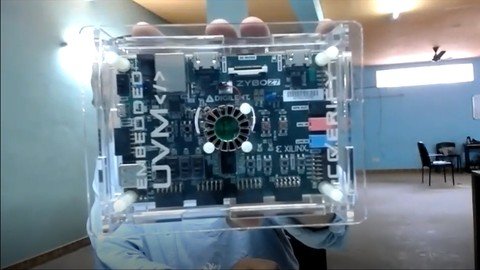
Last updated 6/2019
MP4 | Video: h264, 1280x720 | Audio: AAC, 44.1 KHz
Language: English | Size: 2.18 GB | Duration: 4h 6m
Opensource Verification and Emulation
What you'll learn
We take a dive into Embedded UVM and its use cases as a platform for Functional Verification and SoC FPGA based Emulation
We learn how to code Embedded UVM powered testbench for a hardware accelerator design IP
The test bench is then adapted to Cyclone V and Ultrascale Zynq based platforms to demonstrate Embedded UVM powered low-cost SoCFPGA based emulation solutions.
Requirements
Basics of UVM is nice to have
Basics of digital design is a must to have
Novice knowledge of opensource EDA flow is nice to have
Description
Of course, there is a requirement for open-source verification, but that's not the only thing we want to cater to. There are other verification trends and challenges which system Verilog and other verification platforms are not able to meet. So, we want to position Embedded-UVM for that. In the past decade or so, the major thing which is making verification tougher than it used to be, is the death of Moore's law.As far as processor frequency goes, it stabilizes at 4GHz and it's coming down as we move to multi-core processors. So, when you look at it from a simulation perspective, post-2005 it is becoming increasingly difficult to run simulations on bigger chips.Chip size keeps increasing, while processor speed is stagnant and hence, simulation is a limiting factor. Simulation speed is going to be limited unless we move to multi-core processors. Contemporary EDA tools run RTL simulations in a multi-core environment. System Verilog doesn't run in a multi-core environment.Therefore, test-bench runs on one thread and RTL runs on multiple threads. RTL is more formal in nature, in sense, it can be synthesized, it can be partitioned, different partitions can run on different processors, while test-bench is behavioral in nature and it cannot be partitioned the way RTL can be.About Speaker:Puneet Goel is a 1994 graduate in Electronics from Punjab Engineering College. He has 24 years of experience in the VLSI industry where he worked for STMicro, Motorola, Texas Instruments and TranSwitch.For the past 8 years, he has been working for Coverity Systems Technology, where he provides verification services and works on creating viable opensource solutions for chip verification. Puneet is the main developer of Embedded UVM.
Overview
Section 1: Introduction
Lecture 1 Introduction
Lecture 2 Introduction to FPGA boards to be used in webinar
Lecture 3 Introduction to E-UVM framework using adder example
Lecture 4 Testcase and E-UVM download links
Section 2: Verification trends and challenges
Lecture 5 Verification perfomance and introduction to FOSSI
Lecture 6 Variation trends and challenges of data network and compute performance
Lecture 7 Testbenches for system level verification and hardware accelerators
Lecture 8 Hardware accelerators from verification perspective
Lecture 9 Hardware accelerators perspective Embedded - UVM
Lecture 10 LIVE QnA with participants about E-UVM multi-threading
Lecture 11 LIVE QnA regarding system-C comparison with E-UVM
Section 3: Embedded UVM and Multicore testbenches
Lecture 12 Introduction to Embedded-UVM
Lecture 13 Embedded-UVM innovation - Multicore UVM
Lecture 14 Multicore E-UVM implementation
Section 4: Productivity and Emulation Features
Lecture 15 Productivity features and interfacing with RTL simulations
Lecture 16 Embedded UVM powered emulation
Lecture 17 Testbench simulation demo with Avalon streaming bus as DUT
Lecture 18 OSI model of communication and UVM transaction explanation
Section 5: Embedded UVM Testbench Architecture and Environment
Lecture 19 Testbench architecture and verilog co-simulation
Lecture 20 Steps and importance of Randomizing object and cloning
Lecture 21 Typical UVM environment comparison in Embedded-UVM and system verilog
Lecture 22 LIVE QnA with webinar participants regarding E-UVM environment
Lecture 23 avst_keccak protocol
Section 6: The DUT - SHA3 core
Lecture 24 Functional details, control & status, data map, output and input
Lecture 25 SHA3 core testbench understanding and running
Lecture 26 LIVE demo on DE10-Nano Cyclone V FPGA board
Lecture 27 LIVE code debug and emulation
Section 7: Assignments and Conclusion
Lecture 28 Assignment explanation and conclusion
Lecture 29 Assignment testcase download links
Freshers and experienced in UVM keen to know about opensource Embedded-UVM technology,Professional UVM engineers keen to know about multi-threaded testbench simulation technology,Anyone looking to learn new opensource technology and be ahead of market
Homepage
https://www.udemy.com/course/vsd-embedded-uvm/
https://rapidgator.net/file/413b2f8b545424b9f630f1effc9a5b63/jneok.Vsd..EmbeddedUvm.part3.rar.html
https://rapidgator.net/file/58a7db68a7468f810d4938aad356674a/jneok.Vsd..EmbeddedUvm.part1.rar.html
https://rapidgator.net/file/a7675ea9d63f6811133d897c950b73d9/jneok.Vsd..EmbeddedUvm.part2.rar.html

https://uploadgig.com/file/download/1a16ef75264c1e06/jneok.Vsd..EmbeddedUvm.part3.rar
https://uploadgig.com/file/download/a418a6398488eec7/jneok.Vsd..EmbeddedUvm.part1.rar
https://uploadgig.com/file/download/ff4985Cc9F62c7cC/jneok.Vsd..EmbeddedUvm.part2.rar

https://nitroflare.com/view/097DF4A4312E528/jneok.Vsd..EmbeddedUvm.part1.rar
https://nitroflare.com/view/826ED2D3EFF08FF/jneok.Vsd..EmbeddedUvm.part3.rar
https://nitroflare.com/view/B21AF312C3CA24F/jneok.Vsd..EmbeddedUvm.part2.rar
Links are Interchangeable - No Password - Single Extraction
